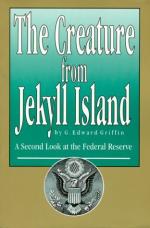
|
| Name: _________________________ | Period: ___________________ |
This quiz consists of 5 multiple choice and 5 short answer questions through Section I. What Creature Is This? Chapter 4 Home Sweet Loan.
Multiple Choice Questions
1. Why were S&Ls popular with those seeking loans in the 1980s?
(a) It was easier for those seeking loans to be approved by S&Ls.
(b) The S&Ls were offering better interest rates on deposits than banks, and that attracted money into them.
(c) S&L loans allowed customers to defer payments for up to one year.
(d) S&L loans were often approved on the spot.
2. How is the Federal Reserve System reviewed in general?
(a) The Federal Reserve System had become known to have the strictest lending standards.
(b) The Federal Reserve System had become the economic leader of the country.
(c) The Federal Reserve System had become the lender of last resort.
(d) The Federal Reserve System had become the nation's first source of lending.
3. What was the main cause of the economic meltdown in 2008?
(a) An unstable world economy was the main cause for the 2008 economic meltdown.
(b) Toxic assets, also known as mortgages and loans were the main cause for the 2008 economic meltdown.
(c) The US deficit was the main cause for the 2008 economic meltdown.
(d) The lack of Congressional legislation was the main cause for the 2008 economic meltdown.
4. Many people feel that the economic system has been rigged to favor what group of people?
(a) People have realized, at least a little bit, that our economic system had been rigged somewhere in the past to favor the rich by stealing from the government revenues.
(b) People have realized, at least a little bit, that our economic system had been rigged somewhere in the past to favor the rich by stealing from the poor and middle classes.
(c) People have realized, at least a little bit, that our economic system had been rigged somewhere in the past to favor the poor by stealing from the rich and middle classes.
(d) People have realized, at least a little bit, that our economic system had been rigged somewhere in the past to favor the middle classes by stealing from the rich and poor classes.
5. How open to questioning were the original participants of the 1910 meeting?
(a) The participants at the 1910 meeting would only agree to talk about the establishment of the Federal Reserve with the New York Times.
(b) None of the participants at the 1910 meeting talked about the establishment of the Federal Reserve in interviews conducted years later.
(c) Most of the participants at the 1910 meeting openly talked about the establishment of the Federal Reserve in interviews conducted years later.
(d) Only some of the participants at the 1910 meeting talked about the establishment of the Federal Reserve in interviews conducted years later.
Short Answer Questions
1. The banking system before the Federal Reserve System allowed banks to lend out what percentage of money against one percent in deposits.
2. What caused the Savings & Loan crisis of the 1980s?
3. What is the definition of a public run on a bank?
4. What may have contributed to the problems of the S&Ls in the 1980s?
5. Prior to the establishment of the Federal Reserves, what caused massive bank failures?
|
This section contains 884 words (approx. 3 pages at 300 words per page) |

|




